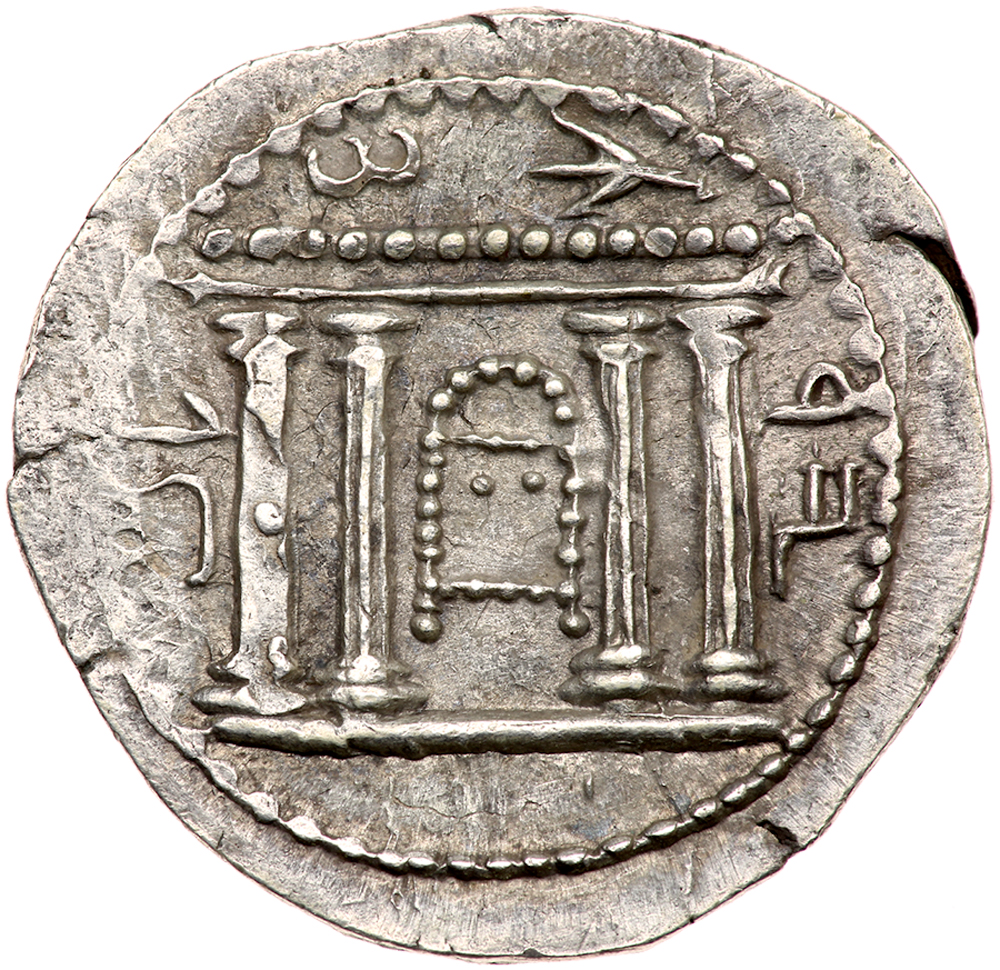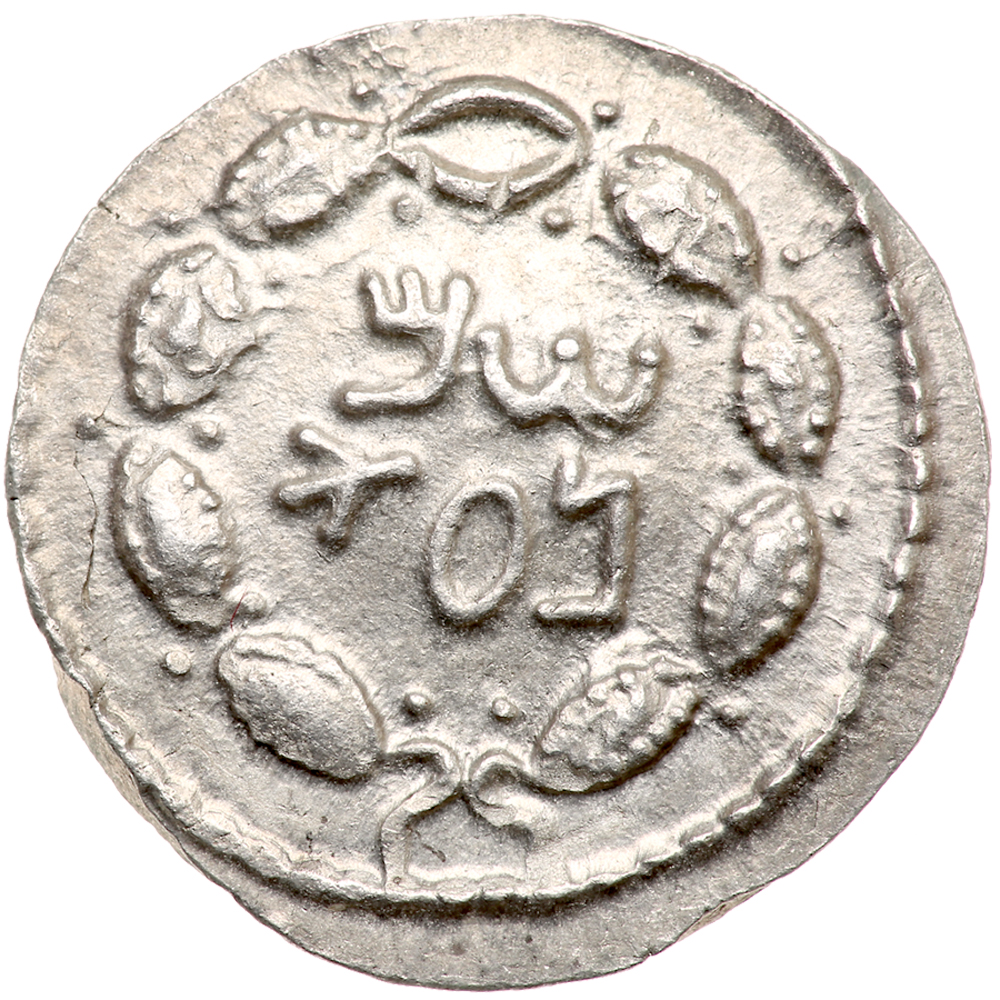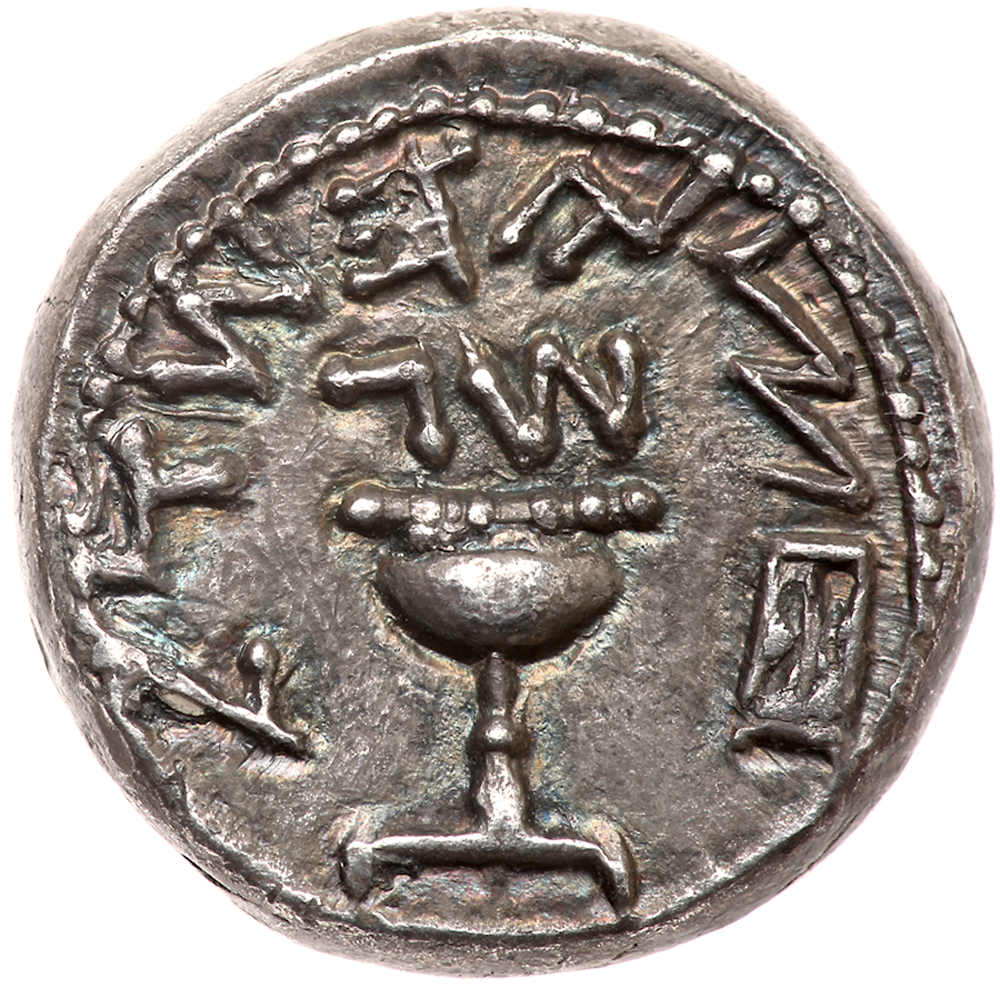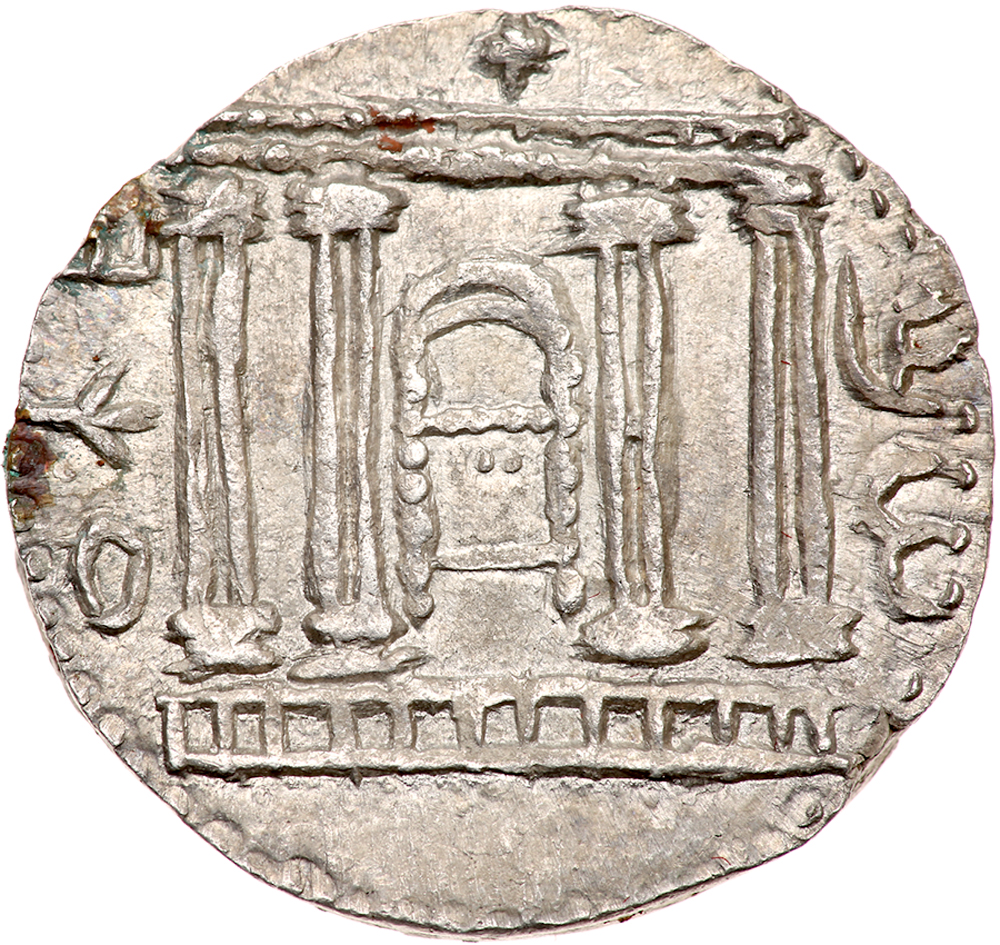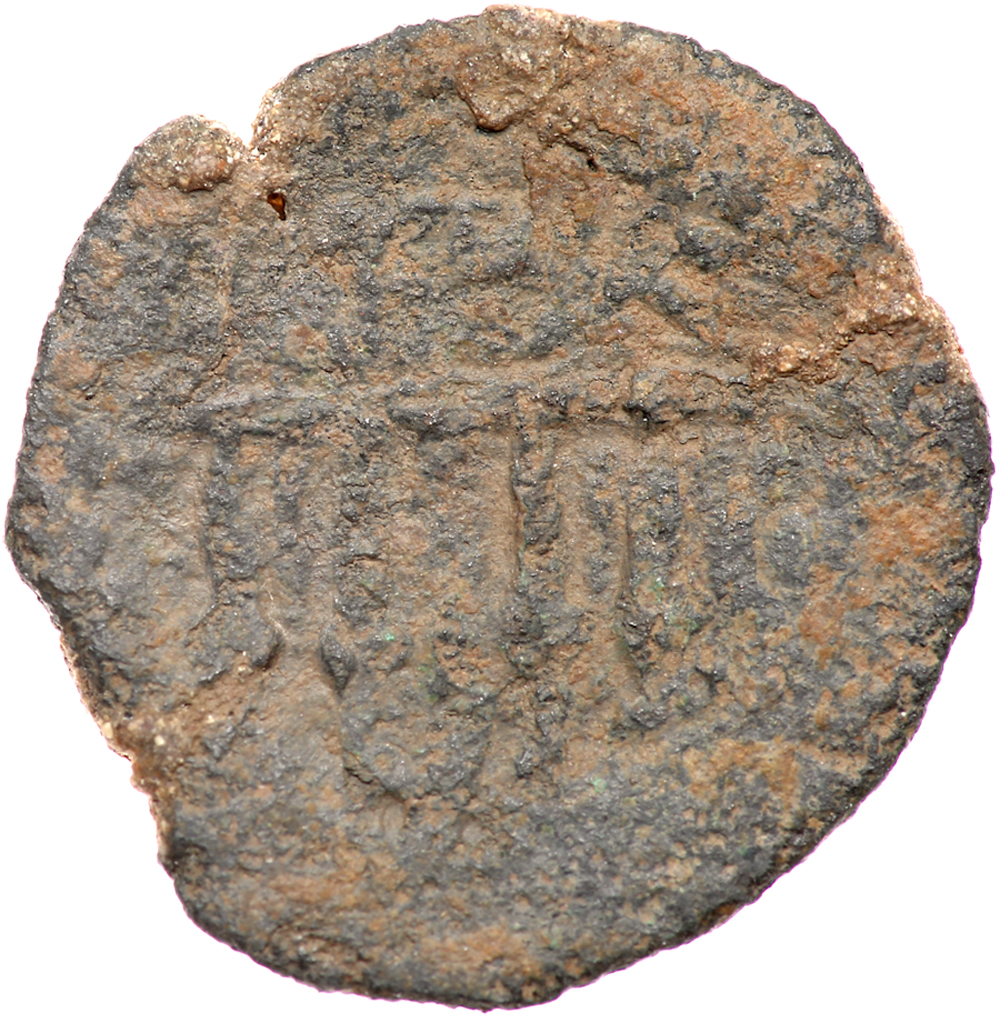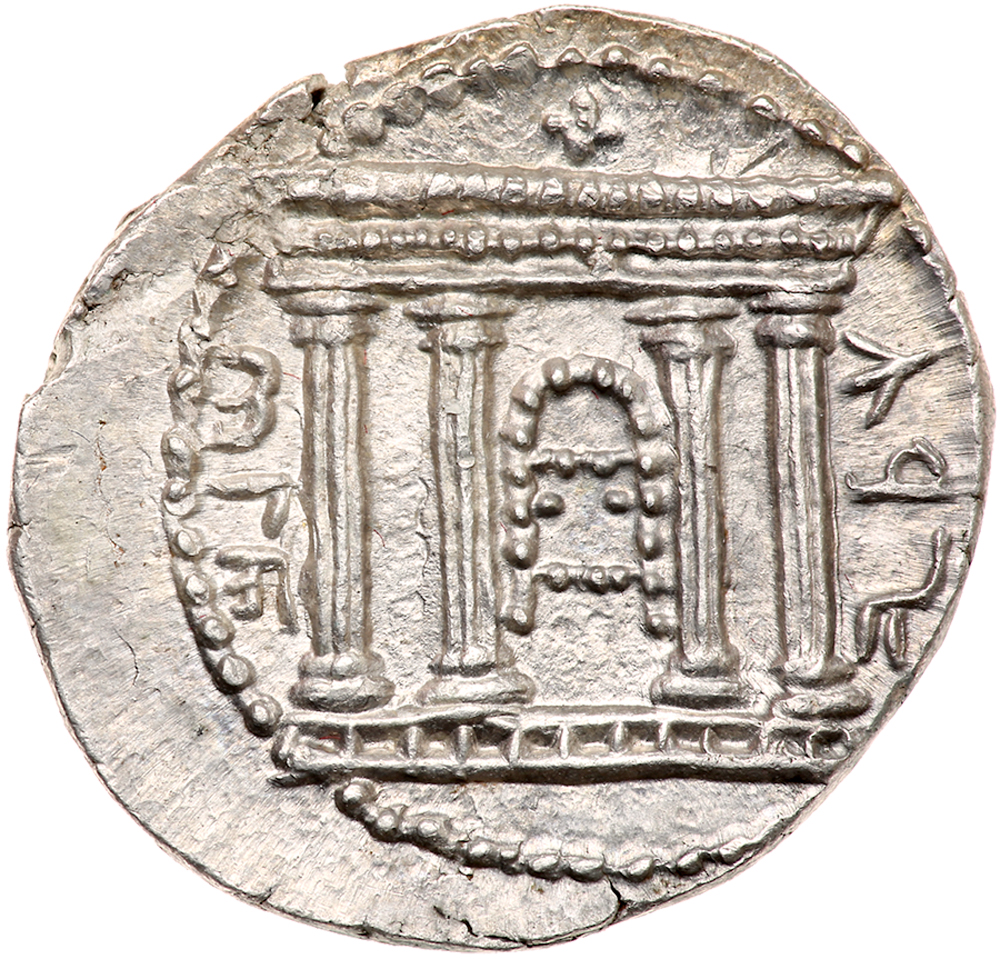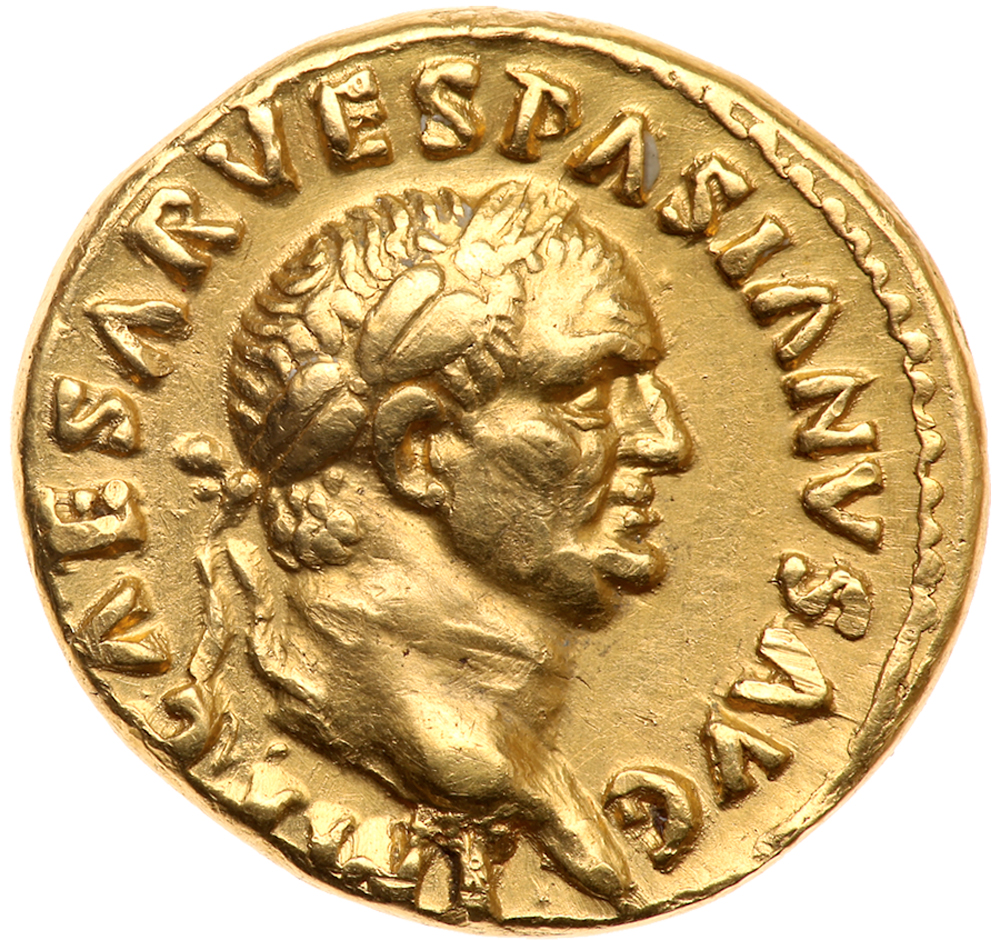Money of the Bible Collection - Coin Auctions
Lot 3010 - Money of the Bible Collection - Ira & Larry Goldberg Coins & Collectibles, Inc. Pre-Long Beach Auction #90Bar Kochba Revolt. Silver Sela (14.50 g), 132-135 CE. Year 1 (132/3 CE). 'Jerusalem', tetrastyle facade of the Temple of Jerusalem; Ark of the Covenant in chest form with semicircular lid and short legs, seen from a narrow side. Reverse: 'Year one of the redemption of Israel', lulav with etrog at left. Mildenberg 3 (O1/R3); TJC 218; Hendin 1373. Very rare and an incredibly choice example of this major Judean rarity. Boldly struck on a full flan with nice wide margins on both sides. Superb Extremely Fine. Ira & Larry Goldberg Coins & Collectibles, Inc. Pre-Long Beach Auction #90Money of the Bible Collection |
|
Lot 3037 - Money of the Bible Collection - Ira & Larry Goldberg Coins & Collectibles, Inc. Pre-Long Beach Auction #90Bar Kochba Revolt. Silver Zuz (3.22 g), 132-135 CE. Undated, attributed to year 3 (134/5 CE). 'Shim'on' (but letters arranged Shim'na), in two lines within a wreath of thin branches wrapped around eight almonds, medallion at top, and tendrils below, pair of dots, one inside and one outside, between each section. Reverse: 'For the freedom of Jerusalem', elongated lyre with three strings. Mildeberg 101 (O16/R69); TJC 272a; Hendin 1424. Delicately toned. Superb Extremely Fine. Ira & Larry Goldberg Coins & Collectibles, Inc. Pre-Long Beach Auction #90Money of the Bible Collection |
|
Lot 3005 - Money of the Bible Collection - Ira & Larry Goldberg Coins & Collectibles, Inc. Pre-Long Beach Auction #90Jewish War. Silver 1/2 Shekel (6.57 g), 66-70 CE. Year 3 (68/9 CE). 'Half of a shekel' around, 'year 3' above, omer cup with pearled rim. Reverse: 'Jerusalem the holy', sprig of three pomegranates. TJC 203; Hendin 1362. Well struck with lovely natural multicolor iridescent toning. Superb Extremely Fine. Ira & Larry Goldberg Coins & Collectibles, Inc. Pre-Long Beach Auction #90Money of the Bible Collection |
|
Lot 3021 - Money of the Bible Collection - Ira & Larry Goldberg Coins & Collectibles, Inc. Pre-Long Beach Auction #90Bar Kochba Revolt. Silver Zuz (3.18 g), 132-135 CE. Year 2 (133/4 CE). 'Shim'' (abbreviating Shi'mon), in triangular form within a wreath of thin branches wrapped around eight almonds, medallion at top, and tendrils below. Reverse: 'Year two of the freedom of Israel', wide lyre with three strings, four dots on sound box. Mildeberg 13 (O4/R7); TJC 238; Hendin 1389. Rare. Lightly toned. Extremely Fine. Ira & Larry Goldberg Coins & Collectibles, Inc. Pre-Long Beach Auction #90Money of the Bible Collection |
|
Lot 3032 - Money of the Bible Collection - Ira & Larry Goldberg Coins & Collectibles, Inc. Pre-Long Beach Auction #90Bar Kochba Revolt. Silver Sela (14.00 g), 132-135 CE. Irregular issue. Undated, attributed to year 3 (134/5 CE). 'Shim'on', tetrastyle facade of the Temple of Jerusalem; Ark of the Covenant in chest form with semicircular lid and short legs, seen from a narrow side; star above. Reverse: 'For the freedom of Israel', lulav with etrog at left. Mildeberg 102 (O23/R77); TJC 268; Hendin 1411a. Rare. A very choice example of the "Irregular issue" with no striking flaws. Lightly toned. Extremely Fine. Ira & Larry Goldberg Coins & Collectibles, Inc. Pre-Long Beach Auction #90Money of the Bible Collection |
|
Lot 3048 - Money of the Bible Collection - Ira & Larry Goldberg Coins & Collectibles, Inc. Pre-Long Beach Auction #90Nerva. Æ Sestertius (26.11 g), AD 96-98. Rome, AD 96. IMP NERVA CAE[S AVG] P M TR P COS III P P, laureate head of Nerva right. Reverse: FISCI IVDAICI CALVMNIA SVBLATA, S C across field, palm tree with two large bunches of dates. RIC 82; BMC 105; BN 97; Hendin 1603 (this coin). A pleasing example of this famous issue with light to medium chocolate brown patina. Clear and full reverse legend. Very rare. Very Fine. Ira & Larry Goldberg Coins & Collectibles, Inc. Pre-Long Beach Auction #90Money of the Bible Collection |
|
Lot 3000 - Money of the Bible Collection - Ira & Larry Goldberg Coins & Collectibles, Inc. Pre-Long Beach Auction #90Judaea, Hasmonean Kingdom. Mattathias Antigonos. Æ Prutah (1.37 g), 40-37 BCE. Trace of 'Mattatayah the High Priest', showbread table. Reverse: [BAΣIΛEΩΣ ANTIΓONOY], seven-branched menorah. TJC 41; Hendin 1168; Menorah Coin Project ATG 07, engraver C, dies O11/R16 (this coin). Extremely Rare and the only ancient Jewish coin depicting the menorah. Very Fine. Ira & Larry Goldberg Coins & Collectibles, Inc. Pre-Long Beach Auction #90Money of the Bible Collection |
|
Lot 3016 - Money of the Bible Collection - Ira & Larry Goldberg Coins & Collectibles, Inc. Pre-Long Beach Auction #90Bar Kochba Revolt. Silver Sela (14.71 g), 132-135 CE. Year 2 (133/4 CE). 'Jerusalem', tetrastyle facade of the Temple of Jerusalem; Ark of the Covenant in chest form with semicircular lid and short legs, seen from a narrow side; star above. Reverse: 'Year two of the freedom of Israel', lulav with etrog at left. Mildeberg 14 (O3/R8); TJC 230a; Hendin 1387. Rare - only five specimens listed in Mildenberg. Well struck on a slightly irregular size flan with underlying luster still present. Superb Extremely Fine. Ira & Larry Goldberg Coins & Collectibles, Inc. Pre-Long Beach Auction #90Money of the Bible Collection |
|
Lot 3027 - Money of the Bible Collection - Ira & Larry Goldberg Coins & Collectibles, Inc. Pre-Long Beach Auction #90Bar Kochba Revolt. Silver Zuz (3.32 g), 132-135 CE. Year 2 (133/4 CE). 'Shim'on', in two lines within a wreath of thin branches wrapped around eight almonds, medallion at top, and tendrils below. Reverse: 'Year two of the freedom of Israel', fluted jug with handle on left; willow branch at right. Mildeberg - (O14/R26), die combination not recorded); Kaufman 12 (O14/R26); TJC -; Hendin -. Extremely Rare. Underyling luster present and lightly toned. Extremely Fine. Ira & Larry Goldberg Coins & Collectibles, Inc. Pre-Long Beach Auction #90Money of the Bible Collection |
|
Lot 3043 - Money of the Bible Collection - Ira & Larry Goldberg Coins & Collectibles, Inc. Pre-Long Beach Auction #90Vespasian. Gold Aureus (7.08 g), AD 69-79. 'Judaea Capta' type. Rome, AD 69/70. IMP CAESAR VESPASIANVS AVG, laureate head of Vespasian right. Reverse: IVDAEA in exergue, Jewess seated right, head resting on hand in attitude of mourning; behind, trophy. RIC 1; BMC 31-4; BN 20-2; Calicó 643; Hendin 1464 (this coin). Boldly struck with excellent detail throughout. Some scattered marks about, none too serious with underlying luster present. About Extremely Fine. Ira & Larry Goldberg Coins & Collectibles, Inc. Pre-Long Beach Auction #90Money of the Bible Collection |

